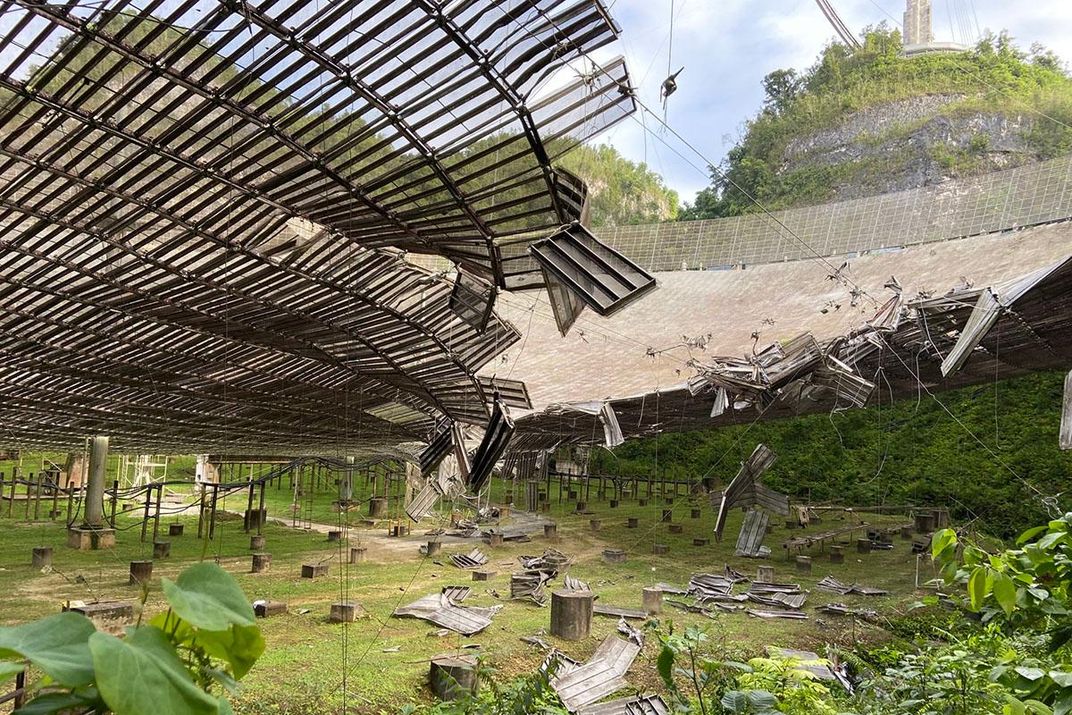A Cable Snapped, and the Arecibo Observatory Went Dark. Here’s Why That Matters
An accident in the middle of the night damaged one of the world’s most important observatories—and scientists still don’t know what caused it
/https://tf-cmsv2-smithsonianmag-media.s3.amazonaws.com/filer/bd/ab/bdab2ded-be2c-4733-8734-13b5474ba1e4/gettyimages-179807607.jpg)
Since it was installed in 1963, the gargantuan Arecibo Observatory has played a key role in the study of the universe. Formally known as the National Astronomy and Ionosphere Center, the radio telescope consists of a huge saucer-like construction, suspended by cables 500 feet above a 1,000-foot-wide dish, all overlooking a panoramic view of the Puerto Rican rainforest.
At 2:45 a.m. in the morning on August 10, one of those supporting cables snapped. The three-inch-wide cable flailed around wildly, damaging the telescope’s Gregorian dome and slashing a 100-foot-long gash through the dish below, reports Dennis Overbye for the New York Times.
Luckily, no one was hurt, reports Daniel Clery for Science magazine. However, the observatory will be shut down temporarily for repairs, scientists announced in a statement from the University of Central Florida (UCF), which manages the observatory for the National Science Foundation.

Officials do not yet know what caused the damage. In a news conference on August 14, researchers said they still needed to assess the full scope of the damage. Subsequent repairs could mean that the observatory is closed for weeks or possibly months, reports Hanneke Weitering for Space.com.
“We have a team of experts assessing the situation,” says Francisco Córdova, observatory director, in the UCF statement. “Our focus is assuring the safety of our staff, protecting the facilities and equipment, and restoring the facility to full operations as soon as possible, so it can continue to assist scientists around the world.”
Ramon Lugo, director of the Florida Space Institute at UCF and principal investigator on the Observatory, tells Science that the cable in question had been added to stabilize the telescope when the Gregorian dome, a large antenna, was installed in the 1990s. The cable had been designed to last for 15 to 20 years, so it’s unclear why it failed, reports Space.com.
As NASA researcher Ed Rivera-Valentín tells Maddie Sofia of NPR’s Short Wave, the Arecibo Observatory has been used for nearly 60 years to track asteroids as they careen toward Earth—a key part in our defense strategy against the interstellar objects, and a practice that helps us avoid the same fate as the dinosaurs.
“Most radio telescopes don’t have the ability to send out light. They only capture light,” Rivera-Valentín explains. “At the observatory, we can send and capture light. When an asteroid's coming by, we are pretty much a flashlight that we turn on. We send radar out to it, and that radar comes back.” That radar helps scientists measure how far an asteroid is from Earth, down to the meter, Rivera-Valentín adds.
The Observatory’s dish antenna was once the largest of its kind in the world, until it was surpassed by China’s Five-hundred-meter Aperture Spherical radio Telescope (FAST) in 2016, per Science.
The site has also played a central role in scientists’ search for extraterrestrial life, reports the Times. In 1974, astronomers sent out the most powerful broadcast ever deliberately beamed into space from Arecibo, aimed at the globular star cluster M13. If any aliens ever encounter and decode the message—which scientists admit is unlikely—they’ll find images of Arecibo telescope, our solar system, DNA and a stick figure of a human, portrayed in sequences of ones and zeroes.
Arecibo Observatory has also long featured prominently in popular culture, showing up in films such as Contact (1997) with Jodie Foster and the James Bond flick Goldeneye (1995), as Passant Rabie reports for Inverse.
As the Times reports, the telescope has faced its share of troubles in the past: In 2017, Hurricane Maria severely damaged the observatory. The National Science Foundation has also been plagued by budget cuts in recent years, which means that funding for research at the Observatory has dropped precipitously from the 1970s to now, reports NPR.
“We’ve been tested before,” adds Córdova during the press conference, per the Times. “This is just another bump in the road.”
/https://tf-cmsv2-smithsonianmag-media.s3.amazonaws.com/accounts/headshot/nora.png)
/https://tf-cmsv2-smithsonianmag-media.s3.amazonaws.com/accounts/headshot/nora.png)